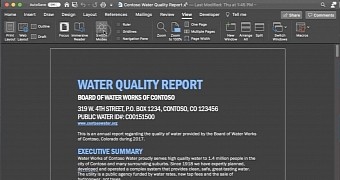
But not all adapters are known to work correctly in Target Disk Mode, so if you can, connect directly to the same port type. Using adapters to connect Thunderbolt to FireWire will usually work, as will Thunderbolt to USB-C. Ideally, you should connect similar ports that is FireWire to FireWire, Thunderbolt to Thunderbolt, or USB-C to USB-C.
#HOW TO SHOW EDIT MODE WORD MAC MAC OS#
Using the Mac OS operating system on the Target Disk Mode Mac to boot a second Mac.Īs you can see, Target Disk Mode can be pretty darned versatile, and may be able to solve a problem you’re having that relates to accessing or sharing data from one Mac to another.Using an optical drive on the Target Disk Mode Mac as if it were attached to your Mac.Troubleshooting the drive of a Mac that can’t boot to the desktop.Copying files from one Mac to another without having to set up file sharing or create a local network.Target Disk Mode can be used for quite a variety of purposes: This handy feature allows you to connect two Macs via FireWire ports, Thunderbolt ports, or USB-C ports, and then share the contents of the Target Disk Mode Mac’s internal drive. To turn off Track Changes, simply click on the Track Changes button or toggle again.Target Disk Mode has been a feature of the macOS since the PowerBook 100 (pictured right) was released way back in 1991. You can also choose to accept or reject all changes at once from the drop down menus beside each option. To do this, simply click on the changed text (or the note in the margin) and then select either Accept or Reject from the Review tab.

If you are reviewing a document, you can either accept or reject changes made by another person. The comment will appear in the right margin of the document. You can also comment on pieces of text by selecting New Comment from the Review tab. When you reformat text, the type of reformat will be noted in a comment in the right margin of the document. When you delete text, the deleted text will be noted in a comment in the right margin of the document. When you add text, the added text will be in a different colour to the normal text – making it easy to spot for reviewers. Any changes you make to the text will be marked by a grey bar on the left side of the changed text. Once Track Changes is turned on, you can start editing the document. Make sure that you change ‘Simple Markup’ to ‘All Markup’ from the drop down bar next to Track Changes.

Either click the Track Changes button (PC) or toggle the Track Changes switch (Mac).Choose the Review tab at the top of the document.You can also follow these steps if you are using the desktop Microsoft Word app: Turn on Track Changes
#HOW TO SHOW EDIT MODE WORD MAC HOW TO#
If you do not know how to use Track Changes, Microsoft has a very useful online guide to using Track Changes. Reviewers can then accept or reject changes. Track Changes will record any text you add, delete, reformat, or comment on. This allows us to clearly see what edits have been made and greatly speeds up the amount of time we spend editing web pages.

In addition, it gives more power to the owner of the document who can accept or reject any changes made to the document.ĭigital communications often shares Word documents containing website content with colleagues across the University, and asks them to use Track Changes to make edits or queries. It is particularly useful when you are sharing documents with other colleagues, because it allows you to see exactly what changes were made, and by whom. In this post, I’ll teach you how to use Track Changes to edit Word documents, and how to accept or reject those changes as a reviewer. Track Changes is a tool in Microsoft Word which allows you to show any markups, changes or comments made to a document.


 0 kommentar(er)
0 kommentar(er)
